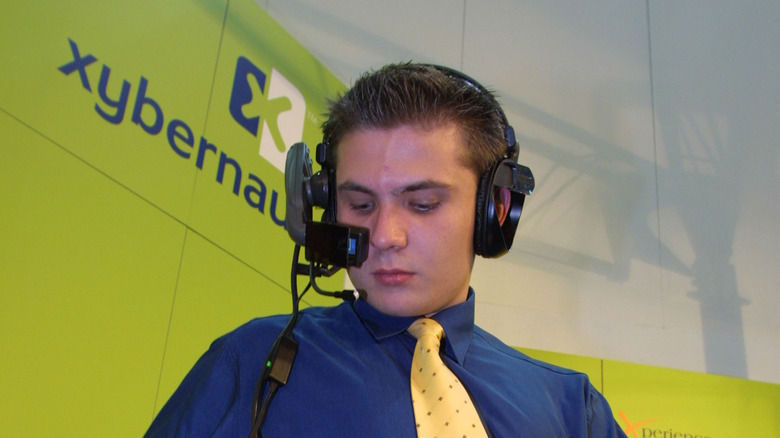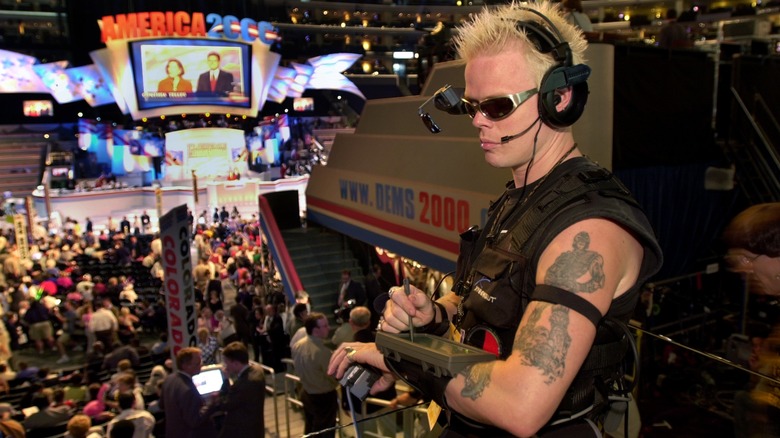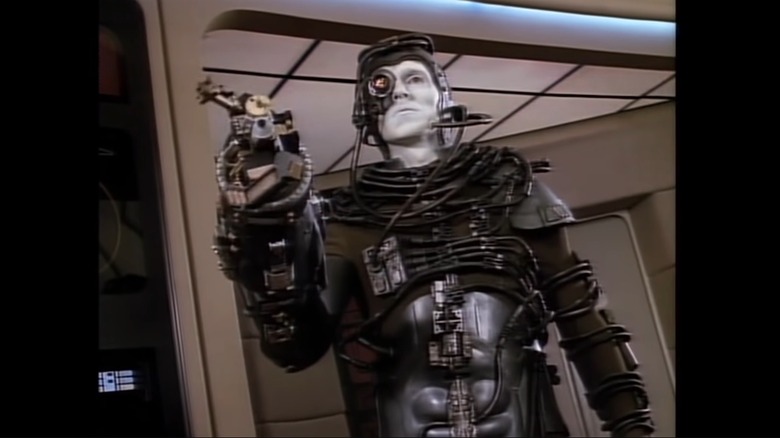This Vintage Wearable Computer Is Considered One Of The Biggest Tech Failures Of All-Time
Let's jump into the Wayback Machine to 2000. The world had indeed taken Prince's advice and partied in 1999, and somehow survived Y2K without a scratch. Everyone breathed a collective sigh of relief and subsequently unleashed a tidal wave of technological gizmos and gadgets unlike anything ever before seen.
In 2000, Apple released the Mac OS, and USBs flashed into existence. The following year, Microsoft opened Windows XP, Apple kicked off the iPod craze, and Microsoft unboxed the first Xbox. In 2002, T-Mobile gave us a Sidekick, Research In Motion debuted the first Blackberry "smartphone," and a small company named Xybernaut brought us a wearable PC called the Poma.
It was a heady time to be sure, but unless it was your job to be neck-deep in tech in the early aughts, you probably never heard about this face computer. While "Poma" sounds more like a disease you'd catch while exploring the jungles of South America than a piece of computer tech, it did stand for something: Personal Media Appliance. But, it wasn't the Virginia-based company's first go at a "wearable" PC.
Xybernaut used all the cool cyberpunk lingo
Xybernaut started in 1990 as Computer Products & Services Inc., founded by former Xerox executive Ed Newman. In 1995, The Washington Post reported that the company had invested millions of dollars into developing the Mobile Assistant (MA), a more than three-pound wearable device and headset combination.
The Mobile Assistant – a forerunner to the Poma — used an IBM-compatible PC with a 486 chip at its heart. It came with a whopping 16 megabytes of RAM and a "huge" 540 mb hard drive. A lithium-ion battery powered the unit to run Microsoft Windows, DOS, and Unix programs. It could be controlled via voice commands (which turned out sketchy at best) or a tiny tethered mouse.
In 1996, CPSI went public and changed its name to Xybernaut. A few years later, it dropped a nine-pound product, called MA-IV, that ran a 233 MHz Pentium MMX processor with 128 MB of RAM, worn around the waist. It did have a massive keyboard the user strapped to their wrist, too.
The Borg-like headset sported an array of goodies, like headphones, a microphone, and a 640x480 pixel display that used a complex system with a one-inch LCD screen that projected images onto a semi-transparent two-inch surface that reflected the image back directly into the wearer's right eye. One print ad listed an MSRP of $9,687, while another source says it retailed for $7,500.
A wearable computer... sort of
In 2001, the New York Times reported Xybernaut was working with IBM and Texas Instruments on its fifth version of the Mobile Assistant (MA V). The slimmed down version weighed just 22 ounces and had shrunk the form factor to about the size of a Sony Walkman. Now, it was powered by a 500 MHz Intel Celeron processor and packed 256 MB of RAM and 5 GB of storage space, and could go all the way up to 32 gigs of hard drive space.
The unit was Bluetooth and FireWire capable and sported a full-duplex built-in stereo sound card. An ATI Technologies Rage Mobility chip with 8 MB SDRAM handled the 3D graphics. The once enormous headset had been streamlined as well. The full-color Olympus Monocular Eye-Trek with 800x600 pixel resolution weighed only three to five ounces and could now easily slip over a pair of glasses, making the user much less Borg-ish.
It was still able to run Windows, Linux, and Unix operating systems, and be augmented with a touch-screen flat-panel display, keyboard or pointing device. However, speech recognition was still the preferred control method. The Times and a Texas Instruments press release placed the cost of a standard model starting around $4,000.
I am Xybernaut, resistance is futile
Then there was the Poma, built in collaboration with Hitachi in 2002 and retailed for just $1,500. Hitachi sold it in Japan as the WIA-100NB Wearable Internet Appliance, while Xybernaut covered the United States, calling it the Personal Media Appliance.
Poma's operating system used Microsoft Windows CE and ran a Hitachi 128MHz 32-bit RISC processor with 32MB of RAM. The 9.8-ounce unit had ports for CompactFlash memory cards and USB devices. Instead of voice-activated controls, the Poma was controlled with a hand-held pointer the user swiped a finger across. It acted like a typical mouse but looked nothing like one. The headset weighed only three ounces and featured a 640x480 pixel resolution mini-monitor that gave the impression of looking at a 13-inch color screen.
The Washington Post reported that Xybernaut didn't manage to sell more than 10,000 of the "wearable computers" over its 15-year tenure. Whatever the case, things came to a head when criminal charges were filed for fraud against three men associated with the 1996 IPO. And there was the fact that the company had lost $162 million since 1990. Xybernaut filed for bankruptcy in 2005.
Even though the comparisons have since become clichéd, every single one of Xybernaut's "wearable" gadgets made the wearer look like a Borg straight outta Delta Quadrant. And maybe that crime alone was worth shutting down over.


